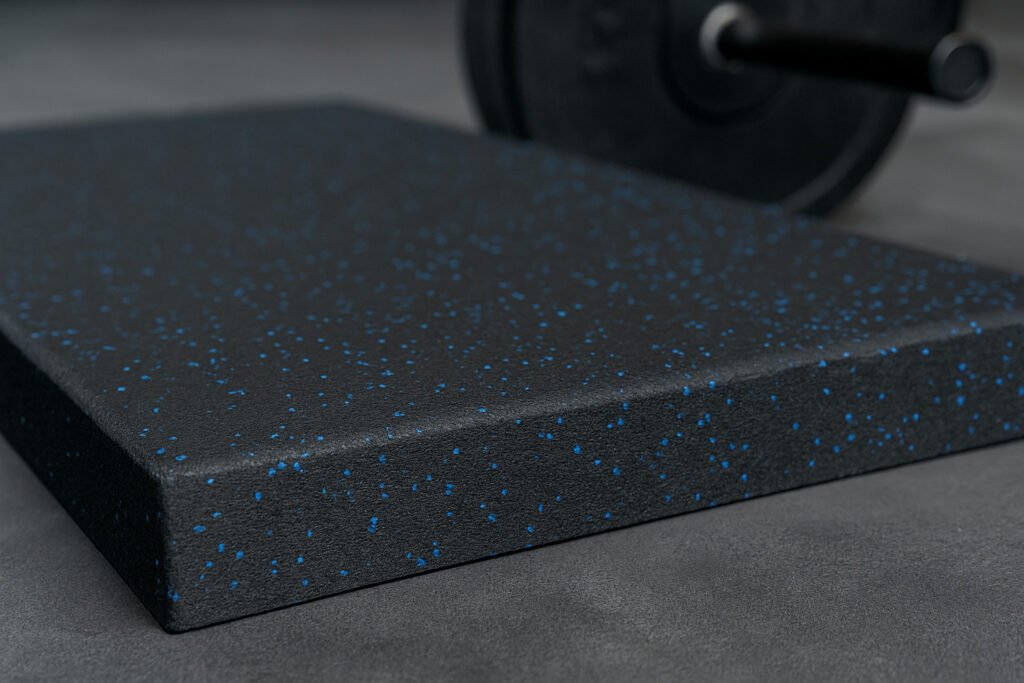How long does gym rubber flooring last?
Buying rubber flooring for a gym is not just about what looks good—it’s about what lasts. If it wears out in 3 years, it wasn’t a good investment.
High-quality rubber gym flooring can last 8 to 15 years or longer, depending on the material, usage, thickness, and how well it’s maintained.

If you’re running a commercial gym, replacing the floor frequently is expensive and disruptive. Let’s look at what impacts lifespan—and how Lanhefloor tiles hold up over time.
What affects the lifespan of gym rubber flooring?
Not all rubber flooring is created equal. How long it lasts depends on more than just how often people use it.
The lifespan of rubber flooring is affected by material quality, thickness, usage level, exposure, and maintenance practices.
Let’s break it down.
1. Material matters
- SBR rubber is durable, cost-effective, and commonly used for tiles.
- EPDM rubber, especially in composite tiles, resists fading, UV, and wear—making it ideal for premium areas.
- EPDM granules used in outdoor applications are designed for weather resistance and can last even longer.
2. Thickness is key
- Thick rubber (20mm–50mm) handles weight drops and wear better.
- Thin rubber rolls (3mm–6mm) wear out faster, especially if misused in strength zones.
3. Usage intensity
- A yoga room sees less wear than a CrossFit rig area.
- Foot traffic, machine vibration, and weight drops all shorten the lifespan if the wrong material is used.
4. Maintenance habits
- Regular cleaning with mild soap extends life.
- Quick cleanup of sweat and debris avoids granule breakdown.
| Factor | Effect on Lifespan |
|---|---|
| High-quality SBR/EPDM | +5 to 10 years |
| 20–50mm thickness | +3 to 5 years |
| Cardio use only | Minimal wear |
| Outdoor use with no UV protection | -3 to 5 years |
| No cleaning or care | -2 to 4 years |
How long do different types of gym flooring last?
We’ve tested and installed our products in high-traffic gyms, home setups, outdoor spaces, and everything in between. Here’s what to expect.
| Product Type | Expected Lifespan | Best Application | Link |
|---|---|---|---|
| Tiny Granule Rubber Tile | 8–12 years | Weightlifting zones | ✅ |
| Composite Rubber Tile | 10–15+ years | High-end commercial gyms | ✅ |
| Puzzle Rubber Tile | 5–10 years | Home gyms / PT zones | ✅ |
| Gym Rubber Roll | 6–10 years | Cardio, yoga, offices | ✅ |
| Outdoor Rubber Floor | 8–15 years | Outdoor walkways / sports | ✅ |
| EPDM Granules | 10–20 years | Playgrounds / poured-in-place | ✅ |
Explore more applications in our project gallery.
How to extend the life of your gym flooring?
Replacing flooring every few years isn’t sustainable. Here’s how to make it last longer:
Choose the right flooring type for each zone
Don’t use a 4mm roll in a weight zone. For strength training, go with tiles that are at least 20mm thick.Rotate and reposition equipment
This avoids uneven wear.Clean weekly
Use a pH-neutral cleaner. Avoid alcohol, bleach, or harsh degreasers.Avoid dragging heavy machines
Roll or lift instead of scraping against the surface.Use beveled edges and ramps
This reduces corner wear and trip risks.Choose certified flooring
All Lanhefloor tiles come with EN1177 and CE certifications for shock absorption and durability.
When should you replace rubber flooring?
Even the best floors wear down eventually. Signs it’s time to replace:
- Deep dents or cracks that don’t recover
- Loss of grip or surface texture
- Persistent odors from bacterial buildup
- Visible subfloor damage
If your floor is showing wear, check out our latest gym rubber tile options or request a custom quote from Lanhefloor.
Conclusion
Rubber flooring in a gym can last 8–15 years—or longer—with the right product, thickness, and care. At Lanhefloor, we build flooring systems that perform under pressure and stand the test of time.
